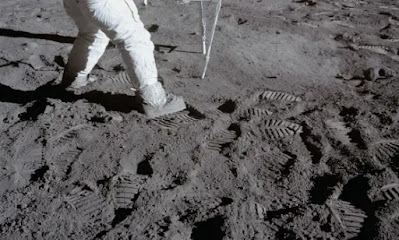Cultural landscapes are a powerful way of conceptualising the interaction of human activities with the space environment. From the surface of Earth to the far reaches of the solar system, there are many levels of designed, organic, and associative landscapes, from rocket launch sites to the Voyager spacecraft in interstellar space. You could say that the entire solar system is now a cultural landscape. I want to focus briefly on two particular landscapes, geostationary orbit and the surface of the Moon.
 |
| Voyager 1. Image courtesy of NASA. |
Geostationary orbit is located about 35, 000 km above the surface of Earth and until recently, when Elon Musk started launching the Starlink megaconstellation into Low Earth Orbit, this is where most of our telecommunications satellites were located. There are currently about 580 spacecraft situated here.
When you look at photos of space junk around Earth, the GEO orbit looks like a faint ring, recalling the ring systems of the outer planets. The ring is maintained by station-keeping manoeuvres; hence it is a product of engineering decisions and could be called a designed landscape. A cultural landscape approach sees cultural value in the structure of the ring, rather than dismissing the satellites as an aggregate of unconnected spacecraft.
 |
| Representation of space debris, showing the GEO ring. Image courtesy of NASA |
Since the USSR probe Luna 2 crashed on the Moon in 1959, there are now over 100 locations with human material culture, ranging from robotic probes, crashed orbiters, and rovers, to crewed landing sites. A key feature of the selenoscape is the interplay between light, dust and shadows. The shadows of the human-made artefacts, with their sharp angles and textural range, are very different to those cast by craters and rocks. The banded bootprints left by the 12 Apollo moonwalkers are another novel texture on the lunar surface. Space archaeologists have compared the Apollo 11 bootprints to the Laetoli footprints, made by bipedal hominin ancestors 3.6 million years ago in volcanic ash. As cultural landscapes, the Apollo sites show how low-gravity and barely any atmosphere shaped the human activities which took place there, and the lasting impression in the shadowscape created by the artefacts they left behind.
 |
| Neil Armstrong's bootprints, 1969. Image courtesy of NASA |
Critically, a cultural landscape lens encourages a view of space as dynamic rather than an empty desolation that you can just remove junk from to return it to a former state. To finish, I want to argue that space is not a special case. Rather, we should look at terrestrial cultural landscapes in a solar system context, to see them as part of a multitude of possible planetary and interplanetary environments, most of which have not yet come into being.
Note: this is from my webinar presentation at the International Council on Monuments and Sites International Scientific Committee on Cultural Landscapes, on 17 April.
See also The Routledge Handbook of Cultural Landscape Practice, 2023

No comments:
Post a Comment